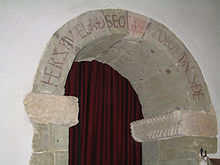Wynn
This article needs additional citations for verification. (April 2012) |
| Ƿ | |
|---|---|
| Ƿ ƿ | |
| (See below) | |
 | |
| Usage | |
| Writing system | Adapted from Futhorc into Latin script |
| Type | Alphabetic and logographic |
| Language of origin | Old English |
| Sound values | [w] /wɪn/ |
| In Unicode | U+01F7, U+01BF |
| History | |
| Development | ᚹ
|
| Time period | ~700 to ~1100 |
| Descendants | Ꝩ ꝩ |
| Sisters | Ꝩ ꝩ |
| Transliterations | w |
| Variations | (See below) |
| Other | |
| Associated graphs | w |
| Writing direction | Left-to-right |
| Name | Proto-Germanic | Old English |
|---|---|---|
| *Wunjō | Wynn | |
| "joy" | ||
| Shape | Elder Futhark | Futhorc |
| Unicode | ᚹ U+16B9 | |
| Transliteration | w | |
| Transcription | w | |
| IPA | [w] | |
| Position in rune-row | 8 | |


Wynn or wyn[1] (Ƿ ƿ; also spelled wen, win, ƿynn, ƿyn, ƿen, and ƿin) is a letter of the Old English alphabet, where it is used to represent the sound /w/.
History
[edit]The letter "W"
[edit]While the earliest Old English texts represent this phoneme with the digraph ⟨uu⟩, scribes soon borrowed the rune wynn ᚹ for this purpose. It remained a standard letter throughout the Anglo-Saxon era, eventually falling out of use during the Middle English period, circa 1300.[2] In post-wynn texts, it was sometimes replaced with ⟨u⟩ but often replaced with a ligature form of ⟨uu⟩, which the modern letter ⟨w⟩ developed from.
Meaning
[edit]The denotation of the rune is "joy, bliss", known from the Anglo-Saxon rune poems:[3]
ᚹ Ƿenne brūceþ, þe can ƿēana lẏt
sāres and sorge and him sẏlfa hæf
blǣd and blẏsse and eac bẏrga geniht.— Lines 22–24 in the Anglo-Saxon runic poem
Who uses it knows no pain,
sorrow nor anxiety, and he himself has
prosperity and bliss, and also enough shelter.— Translation slightly modified from Dickins (1915)
Miscellaneous
[edit]It is not continued in the Younger Futhark, but in the Gothic alphabet, the letter 𐍅 w is called winja, allowing a Proto-Germanic reconstruction of the rune's name as *wunjô "joy".
It is one of the two runes (along with thorn, þ) to have been borrowed into the English alphabet (or any extension of the Latin alphabet). A modified version of the letter wynn called vend was used briefly in Old Norse for the sounds /u/, /v/, and /w/.
The rune may have been an original innovation, or it may have been adapted from the classical Latin alphabet's P,[4] or Q,[citation needed] or from the Rhaetic's alphabet's W.[5] As with þ, the letter wynn was revived in modern times for the printing of Old English texts, but since the early 20th century, the usual practice has been to substitute the modern ⟨w⟩.
Unicode
[edit]
The following wynn and wynn-related characters are in Unicode:[6]
- U+01F7 Ƿ LATIN CAPITAL LETTER WYNN
- U+01BF ƿ LATIN LETTER WYNN
- U+16B9 ᚹ RUNIC LETTER WUNJO WYNN W
- U+A768 Ꝩ LATIN CAPITAL LETTER VEND
- U+A769 ꝩ LATIN SMALL LETTER VEND
- U+A7D4 <reserved-A7D4>[7]
- U+A7D5 ꟕ LATIN SMALL LETTER DOUBLE WYNN[8]
Computing codes
[edit]| Preview | Ƿ | ƿ | ||
|---|---|---|---|---|
| Unicode name | LATIN CAPITAL LETTER WYNN | LATIN SMALL LETTER WYNN | ||
| Encodings | decimal | hex | dec | hex |
| Unicode | 503 | U+01F7 | 447 | U+01BF |
| UTF-8 | 199 183 | C7 B7 | 198 191 | C6 BF |
| Numeric character reference | Ƿ |
Ƿ |
ƿ |
ƿ |
References
[edit]- ^ "wyn". Oxford English Dictionary (Online ed.). Oxford University Press. (Subscription or participating institution membership required.)
- ^ Freeborn, Dennis (1992). From Old English to Standard English. London: MacMillan. p. 25. ISBN 9780776604695.
- ^ Dickins, Bruce (1915). Runic and Heroic Poems of the Old Teutonic Peoples. Cambridge: Cambridge University Press. p. 14–15.
- ^ Odenstedt, Bengt (1990), On the Origin and Early History of the Runic Script, Typology and Graphic Variation in the Older Futhark, Uppsala, ISBN 91-85352-20-9
{{citation}}: CS1 maint: location missing publisher (link). - ^ Gippert, Jost, The Development of Old Germanic Alphabets, Uni Frankfurt, archived from the original on February 25, 2021, retrieved March 21, 2007.
- ^ "UCD: UnicodeData.txt". The Unicode Standard. Retrieved November 22, 2022.
- ^ This character has been approved to be encoded as LATIN CAPITAL LETTER DOUBLE WYNN in Unicode 17.0. See here.
- ^ Everson, Michael; West, Andrew (October 5, 2020). "L2/20-268: Revised proposal to add ten characters for Middle English to the UCS" (PDF).
